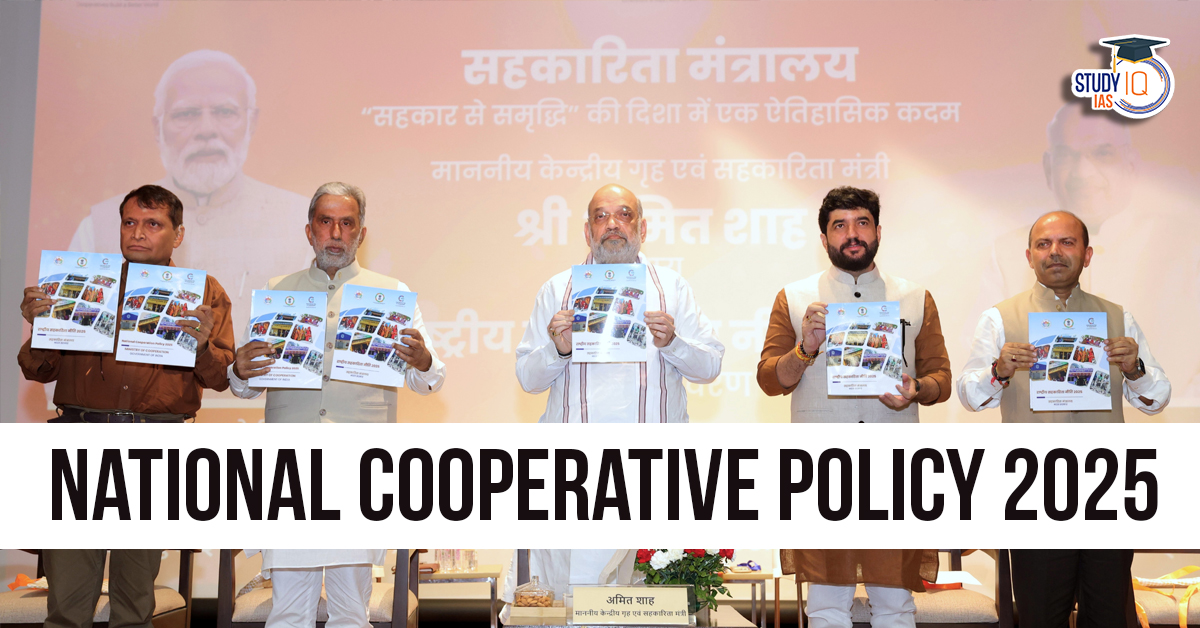Table of Contents
Context: Union Home Minister Amit Shah has announced a new National Cooperative Policy, replacing the 23-year-old existing framework to strengthen and modernise India’s Cooperative Sector.
About National Cooperative Policy 2025
- Launched by Union Home and Cooperation Minister Amit Shah in New Delhi.
- Replaces the previous 2002 cooperative policy, after 23 years.
- Aligned with the vision of “Sahkar se Samriddhi” (Prosperity through Cooperation).
- Designed to guide the sector’s growth over the next 20 years.
Objectives
- Strengthen the institutional capacity of cooperatives.
- Expand cooperatives into new and emerging sectors.
- Promote inclusivity, transparency, and village-level economic empowerment.
- Align cooperatives with national development goals.
Political and Historical Context
- Follows the creation of a dedicated Ministry of Cooperation in 2021.
- India has over 4 lakh cooperative societies, reaching 31 crore people.
- Aims to expand presence in states like Uttar Pradesh and Bihar.
- Target: 30% increase in cooperative societies nationwide.
Six Core Pillars of the Policy
- Strengthening foundational systems
- Revitalising existing cooperatives
- Digitalisation and future readiness
- Inclusive outreach and participation
- Expanding into new sectors
- Youth engagement and capacity building
Key Goals by 2034
- Triple the sector’s contribution to GDP.
- One cooperative society in every village.
- Engage 50 crore citizens in cooperative activities.
Expansion into New Sectors
- Support for cooperatives in:
- Green energy
- Tourism
- Insurance
- Taxi services (Sahkar Taxi)
- Primary Agricultural Credit Societies (PACS) to take up:
- Fuel & LPG distribution
- Jan Aushadhi Kendras
- Common Service Centres (CSCs)
- Rural schemes like Har Ghar Jal and PM Surya Ghar Yojana
Model Cooperative Villages
- Each tehsil will develop 5 model villages in collaboration with:
- State cooperative banks
- NABARD
- Focus on:
- Dairy, Fishery, Floriculture, Agri-services
- Women and tribal empowerment (White Revolution 2.0)
Institutional Reforms and Modernisation
- Full computerisation of PACS
- Tech-driven governance and monitoring
- Cluster tracking systems for performance evaluation
- Legal review every 10 years
- Over 83 reform points identified:
- 58 under implementation, 3 completed
Education and Training
- Establishment of Tribhuvan Sahakari University
- Aimed at professional education and cooperative leadership training
Economic Impact (Current Role of Cooperatives)
- 20% of India’s agricultural credit
- 35% of fertiliser distribution
- 30%+ of sugar production
- 10% of milk production
- 21% of the fishing sector
- 13% of wheat and 20% of paddy procurement
History of Cooperatives in India
Early Phase
- 1904: The Cooperative Credit Societies Act was enacted by the British.
- 1912: Broader Cooperative Societies Act introduced, expanding scope.
Post-Independence
- Cooperatives are included in the Directive Principles of State Policy (Article 43B).
- Rapid expansion in agriculture, credit, dairy, sugar, housing, and fisheries.
- Landmark movements like Amul (White Revolution) were built on cooperative models.
Challenges Over Time
- Political interference
- Lack of autonomy
- Weak governance and transparency
- Ineffective representation of women, youth, and marginalised communities
|
97th Constitutional Amendment (2011) |
Purpose
Key Provisions
Legal Challenge
|


 SLAPP Suits: Meaning, Examples, Impact o...
SLAPP Suits: Meaning, Examples, Impact o...
 Finance Commission of India, Articles an...
Finance Commission of India, Articles an...
 High Number of Pending Cases in Supreme ...
High Number of Pending Cases in Supreme ...

























